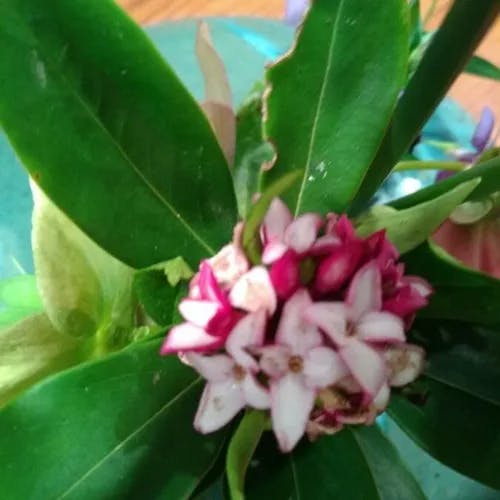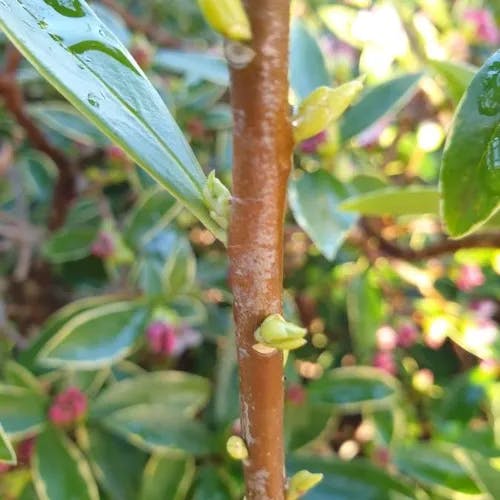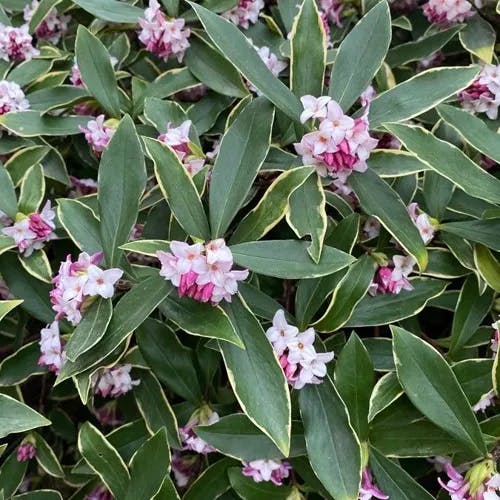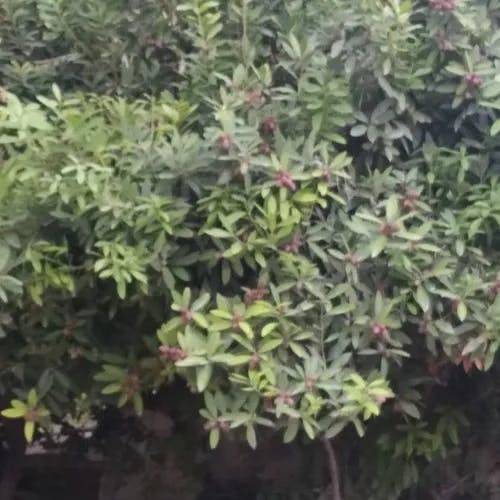Daphne odora, commonly known as winter daphne, is a species of flowering plant in the family Thymelaeaceae. It is native to China, Japan, and Korea, but has been widely cultivated in other regions for its fragrant flowers. The plant is an evergreen shrub, typically reaching a height and spread of 1-1.5 meters. It has leathery, simple leaves that are lanceolate to elliptical in shape. The leaves are dark green on top and pale green underneath, providing a striking contrast. The flowers of Daphne odora are highly fragrant, hence the common name winter daphne. They are small, usually less than 1 cm in diameter, and are borne in clusters at the ends of the branches. The flowers are typically pink or purple on the outside and white on the inside, although there are some cultivars with different color patterns. The fruit of Daphne odora is a small, red drupe. It is not edible and can be toxic if ingested. Despite this, the fruit is quite attractive and can add to the ornamental value of the plant. Daphne odora is relatively easy to grow, but it does have some specific requirements. It prefers well-drained soil and a location with partial shade. It is also somewhat sensitive to cold, so it may need protection in colder climates. In terms of symbolism, Daphne odora is often associated with sweetness and bashfulness. This is likely due to its fragrant flowers and the fact that it often blooms in the late winter or early spring, when many other plants are still dormant. There are several cultivars of Daphne odora available, including 'Aureomarginata', which has leaves edged in yellow, and 'Rubra', which has deep pink flowers. These cultivars can provide additional interest and variety in the garden.
Winter Daphne
- Common name
- Winter daphne,Fragrant Daphne
- Scientific name
- Daphne odora
Basic Information
- Thymelaeaceae Family Daphne Genus Winter Daphne Species
- Thymelaeaceae > Daphne > Daphne odora
- 83%
- The Completeness of This Encyclopedia
Please help us complete the encyclopedia, Terrarium is a encyclopedia service to be completed with everyone in the world. Currently, this page is 83% complete. For more information on how to contribute, please click here.
- Shrub
- Height
- 100cm ~ 150cm
- Flower Color
- Leaf Color
- Anthesis
- spring
- Sunlight Exposure
Full Sun Long hours of sunlight from morning to afternoon Partial Shade A location in the shade of a tree or where either the morning or afternoon is shaded Full Shade A place where there is no direct sunlight
- Partial Shade
- Hardiness Zones
This is an indicator to know to which zone each plant can winter. Knowing the zone of each plant gives you an idea of the cold temperature resistance when grown in the ground without a roof. 2: -42.7 to -40.0 3: -39.9 to -34.4 4: -34.3 to -28.9 5: -28.8 to -23.3 6: -23.2 to -17.8 7: -17.7 to -12.2 8: -12.1 to -6.7 9: -6.6 to -1.1 10: -1.0 to 4.4 11: 4.5 to 10.0
- 7-9'
- Cold resistance
- Fair
- Heat resistance
- Fair
- Habitat of origin
- China, Japan
- Growth Rate
- Slow
What is Winter Daphne (Daphne odora)?
What is Winter Daphne (Daphne odora)
Flower meaning
Daphne odora, commonly known as Winter daphne, is a plant with a rich history in the language of flowers. In American flower language, it is often associated with phrases such as "Glory to the Heavens," "Sweets to the Sweet," and "Eternal Fragrance." The phrase "Glory to the Heavens" is particularly significant, as it reflects the plant's heavenly scent and its ability to bloom even in the coldest winter months, symbolizing resilience and divine beauty. However, it is not recognized as a birth flower in the American tradition. Please note that the language of flowers can vary greatly depending on cultural and regional differences. This information is based on the common interpretations in American flower language and may not be universally applicable.
Calendar of Winter Daphne (Daphne odora)
Calendar
Daphne odora, also known as winter daphne, typically begins to bloom in late winter to early spring in the United States. The peak blooming period usually occurs in February and March, when the plant is covered in clusters of fragrant, pink-purple flowers. The blooming period can last for several weeks, depending on the local climate and growing conditions. To extend the flowering time, it is recommended to plant Daphne odora in a location with partial shade and well-drained soil. Regular watering, especially during dry periods, can also help to prolong the bloom. However, avoid overwatering as this can lead to root rot, which can shorten the flowering period and potentially kill the plant. Pruning immediately after flowering can also encourage a second bloom, although this is not guaranteed. In colder regions, providing some protection from harsh winter weather can help to ensure a healthy bloom in the spring.
How to grow Winter Daphne (Daphne odora)
Watering
Daphne odora, also known as Winter daphne, requires careful watering to thrive. The soil should be kept moderately moist, but not waterlogged. During the growing season, from spring to early fall, water the plant once a week. Approximately one inch of water should be sufficient, but this can vary depending on the size of the plant and the soil type. In the winter months, reduce watering to once every two weeks. However, if the soil appears dry, water the plant immediately to prevent it from drying out. It's important to note that Daphne odora is sensitive to overwatering, which can lead to root rot. Therefore, it's crucial to ensure good drainage in the soil. Use a moisture meter to check the soil's humidity level before watering. A reading of 5 on a scale of 1 to 10 indicates optimal soil moisture for this plant.
Soil and Fertilizer
Daphne odora, also known as Winter daphne, prefers well-drained, loamy soil. The soil should be rich in organic matter, which can be achieved by adding compost or well-rotted manure. The ideal soil pH for this plant is slightly acidic to neutral, ranging from 6.0 to 7.0. Fertilizer application should be done in early spring, using a balanced, slow-release fertilizer with an NPK ratio of 10-10-10. Apply the fertilizer at a rate of 1 pound per 100 square feet of soil. It's important to water the plant thoroughly after fertilizing to help the nutrients penetrate the soil. Avoid over-fertilizing as it can lead to salt build-up in the soil, which is harmful to the plant. Regular soil testing is recommended to monitor nutrient levels and pH, and adjust fertilization practices accordingly. Remember, Daphne odora is a low-maintenance plant and doesn't require heavy feeding.
Sunlight and Place
Daphne odora, also known as Winter daphne, is a shade-loving plant that prefers partial to full shade. It can tolerate morning sunlight but needs protection from the intense afternoon sun, which can scorch its leaves. The plant thrives in temperatures between 60°F and 75°F (15°C - 24°C), but it can withstand colder temperatures down to 20°F (-6°C). However, it is not heat-tolerant and may struggle in temperatures above 80°F (27°C). During the summer, it's best to place the plant in a shaded area to protect it from the heat. In winter, it can tolerate cold but should be protected from harsh frosts. Daphne odora doesn't require a specific amount of sunlight per day, but it does best in dappled shade. Its strength in sunlight is moderate, and it can tolerate a few hours of direct sunlight in the morning.
Advanced Information of Winter Daphne (Daphne odora)
Pruning
Daphne odora, also known as Winter daphne, requires minimal pruning. Pruning is necessary to maintain the plant's shape, remove dead or diseased branches, and encourage new growth. The best time to prune Daphne odora is in late spring or early summer, after the plant has finished blooming. When pruning, make clean cuts at a 45-degree angle just above a leaf node or bud. Avoid heavy pruning as this can stress the plant and potentially lead to disease. After pruning, apply a balanced slow-release fertilizer to support new growth and keep the plant healthy. Ensure the pruned area is kept clean and free from pests. Regular inspection of the plant for signs of disease or pest infestation is recommended. Remember, less is more when it comes to pruning Daphne odora.
Planting and Harvest
Daphne odora, also known as Winter daphne, is a fragrant flowering plant that can be grown in pots or in-ground. For potted plants, choose a pot with good drainage and use a well-draining soil mix. Plant the Daphne at the same depth it was in its nursery pot. Water thoroughly after planting, but then only when the top inch of soil is dry. Daphne odora prefers a cool, partially shaded location. For repotting, do so in the spring, moving to a slightly larger pot. Carefully remove the plant from its current pot, place in the new pot, and fill in with soil. Water thoroughly after repotting. Misshowing can occur if the plant is overwatered or exposed to extreme temperatures. Ensure proper care to maintain the health and beauty of your Daphne odora.
Propagation
Daphne odora, also known as Winter daphne, is best propagated through semi-hardwood cuttings. To do this, select a healthy branch of the plant in late summer or early autumn. Cut a 4-6 inch section, ensuring it includes a node (the point where a leaf joins the stem). Remove the lower leaves and dip the cut end in rooting hormone to stimulate root growth. Plant the cutting in a pot filled with a mixture of peat and perlite, ensuring the node is buried. Cover the pot with a plastic bag to create a humid environment and place it in a warm, shaded area. Keep the soil moist but not waterlogged. Roots should develop within 6-8 weeks. Once established, the new plant can be transferred to a larger pot or directly into the garden. Seed propagation is not typically used as it is less reliable and seeds can take up to 18 months to germinate.
Pests and Diseases
Daphne odora, also known as Winter daphne, is a fragrant flowering plant that can be susceptible to a variety of pests and diseases. One common pest is the vine weevil (Otiorhynchus sulcatus), an insect that can cause significant damage to the plant's roots and leaves. The larvae feed on the roots, while the adults chew on the leaves, leading to a weakened plant that may eventually die. Regular inspection and use of appropriate insecticides can help manage this pest. Another pest that can affect Daphne odora is the aphid. These small insects suck the sap from the plant, causing the leaves to curl and yellow. Aphids can be controlled by introducing natural predators, such as ladybugs, or by using insecticidal soaps. Daphne odora is also susceptible to a fungal disease known as Southern blight (Sclerotium rolfsii). This disease causes wilting and yellowing of the leaves, and can eventually lead to plant death. It is caused by a soil-borne fungus and can be prevented by ensuring good drainage and avoiding overwatering. Root rot is another disease that can affect Daphne odora. This is typically caused by overwatering or poor drainage, leading to a fungal infection in the roots. Symptoms include wilting, yellowing leaves, and stunted growth. To prevent root rot, ensure the plant is planted in well-draining soil and avoid overwatering. Finally, Daphne odora can be affected by leaf spot diseases, caused by various fungi or bacteria. These diseases cause spots on the leaves, which can lead to leaf drop if severe. Regular inspection, removal of affected leaves, and use of appropriate fungicides or bactericides can help manage leaf spot diseases.
Habitat of Winter Daphne (Daphne odora)
Habitat
Toxicity of Winter Daphne (Daphne odora)
Health Benefits
- edible
- Inedible
- Toxic
- toxic
NO DATA
Toxic for dogs and cats
NO DATA
Q&A of Winter Daphne (Daphne odora)
- How to care for Winter Daphne by zone?
Daphne odora, commonly known as Winter Daphne, thrives most optimally within USDA hardiness zones 7 to 9. Within these specified zones, it necessitates well-draining soil with a slightly acidic pH level and exposure to partial to full sunlight. Watering should be conducted in moderation, ensuring that the soil maintains moisture but doesn't become waterlogged. For regions with colder climates (below zone 7), it's advisable to cultivate Winter Daphne in containers that can be relocated indoors during the harsh winter period. In contrast, for areas with hotter climates (above zone 9), providing additional shade and adequate watering becomes essential to shield it from scorching and dehydration. Regularly trimming the plant after its flowering phase not only preserves a compact form but also encourages robust growth. It's crucial to bear in mind that Winter Daphne is highly sensitive to disruptions in its root system, so refrain from frequent repotting or relocating. Lastly, it's imperative to be aware that all parts of the Winter Daphne are toxic if ingested, necessitating caution when in proximity to children and pets.
- What are the diverse Winter Daphne varieties?
Daphne odora, commonly known as Winter Daphne, presents a delightful array of varieties. Among these, the most prevalent selections include 'Aureomarginata,' recognized for its variegated leaves and charming pink blossoms, and 'Alba,' celebrated for its pristine white flowers. Another notable variety is 'Zuiko Nishiki,' renowned for its vigorous growth and striking deep pink blooms. 'Rogbret,' also known as Rebecca, is a newer addition to the lineup, characterized by its variegated leaves adorned with broader yellow margins and exquisitely fragrant pink flowers. Each of these varieties possesses its own distinctive attributes, yet they all share the Winter Daphne's hallmark feature of fragrant flowering, typically occurring from late winter to early spring. It's essential to exercise caution, as all parts of these plants are toxic when ingested.
0
0
- Moonlight Parfait How do you grow daphne in winter?
To cultivate Winter Daphne, scientifically labeled as Daphne odora, effectively throughout the winter season, it's essential to create the right environment for the plant. This perennial shrub thrives in a sheltered spot with partial shade, ideally in soil that is well-draining and slightly acidic. During winter, shield the plant from harsh frosts and chilly gusts of wind, as these elements can harm both the leaves and the blossoms. Applying a layer of mulch around the plant's base serves as insulation for the roots, preserving moisture and warmth. Keep in mind that Daphne odora is a slow-growing specimen, demanding patience from gardeners. Consistent watering and periodic nourishment with a balanced fertilizer are vital for fostering robust growth. However, exercise caution to avoid excessive watering, which could lead to root rot. Lastly, it's crucial to understand that all parts of the Daphne plant are toxic if consumed. Handle the plant with care and ensure it's kept out of reach of both pets and children.
0
0
- Is there a recommended way to choose Daphne odora?
Daphne odora, also recognized as winter daphne, is a fragrant flowering plant. When you're in the market for seedlings, keep an eye out for those displaying robust, vibrant green leaves and a sturdy, healthy stem. Steer clear of any plants showcasing yellowed leaves or any signs of disease or pest infestation. In the realm of seeds, favor those that exhibit plumpness and firmness to the touch. Seeds that appear shriveled or soft might not germinate as successfully. Daphne odora comes in two primary varieties: 'Aureomarginata,' boasting leaves adorned with yellow edges, and 'Rubra,' known for its charming pink flowers. 'Aureomarginata' tends to withstand colder climates with ease and thrives in partial shade, while 'Rubra' craves more sunlight and warmth. Your choice between these varieties should align with your specific climate and garden conditions. Always bear in mind that Daphne odora flourishes in well-drained soil and prefers a sheltered spot. When seeking out plants or seeds, opt for a reputable nursery that can offer tailored care instructions tailored to your chosen variety.
- How to take care of Eternal Fragrance Daphne in winter?
To keep your Eternal Fragrance Daphne (Daphne odora) thriving through the winter season, it's vital to provide adequate protection from challenging weather conditions. This plant, also known as Winter Daphne, lacks robust frost resistance. If temperatures in your area plummet below freezing, contemplate moving potted specimens indoors or providing protective covers for those in the ground. Ensure the soil maintains proper drainage since Daphne odora is susceptible to root rot, especially in excessive winter moisture. Adding mulch around the plant's base can help retain moisture and offer insulation against the cold. When it comes to pruning, exercise restraint and limit it to the period following the flowering phase. This plant produces blossoms on older wood, so heavy winter pruning should be avoided to prevent stress and potential reductions in spring blooms. Lastly, despite Daphne odora's general low-maintenance nature, it's essential to maintain vigilance for any signs of disease or pest infestations, particularly during the winter season when the plant may be more vulnerable. Consistent care and attention will secure the prosperity of your Eternal Fragrance Daphne throughout winter and into spring.












